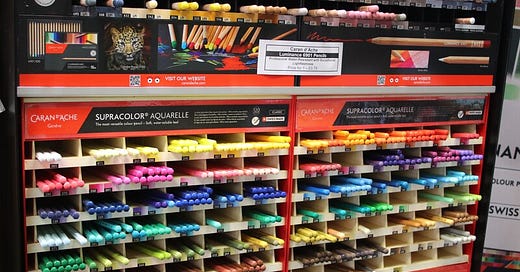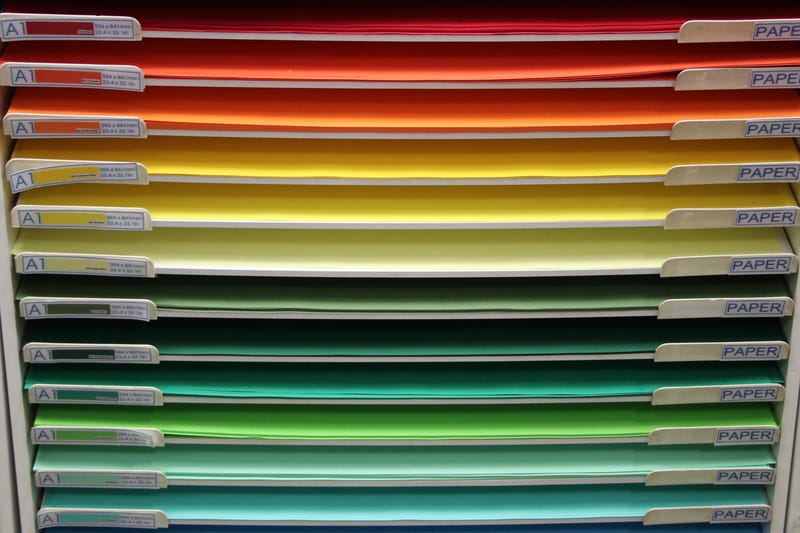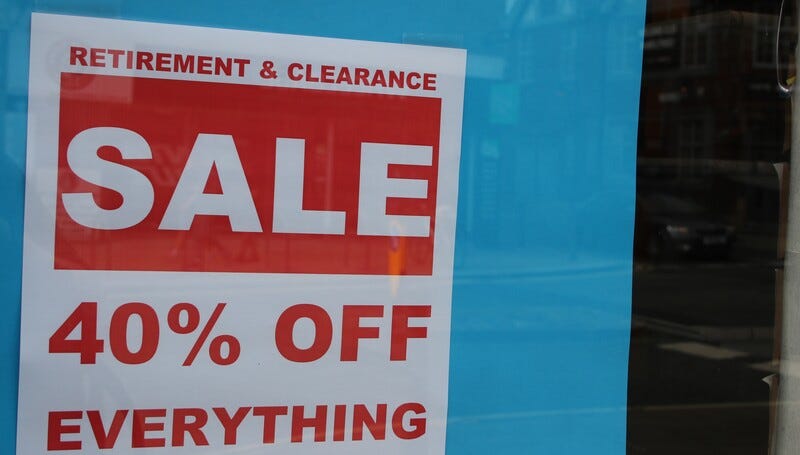Everything Must Go: Demise of an Art Shop
The closure of a local institution underlines appreciation of art is formed through first-hand experience, as well as highlighting the dangers of sentimentalism.
The day after the announcement appeared in the local newspaper, there was a queue of people outside the art shop. After 70 years, the town’s last art shop was closing and people wanted to get bargains and pay their respects. The windows were plastered with signs declaring that “Everything Must Go” at a 40% discount. The shop was busier than ever before, with members of the art society exchanging gossip and comparing deals; pensioners came in to get watercolours. Students were there to buy sketchbooks and paint sets; others waited in line, holding handfuls of greetings cards. Talking on her phone a woman was described brushes before becoming frustrated with the plethora of types and insisting her interlocutor come to see items in person. I bought a pad of watercolour paper, ink and brushes, eyeing the large sheets of cotton-rag paper with deckle edges and watermarks.
For once, this is not another case of a bricks-and-mortar store falling by the wayside because of online – or even out of town – competition. The owners are retiring and they could not find a proprietor willing to take on the lease and stock. Art stock is very expensive. Those racks of watercolour paints (some as small as 8 ml) range in price from £5 to £25 per tube with perhaps 80 colours in a rack and 5 to 10 tubes of each paint. That is just one range of one type of paint. Investment in stock is substantial, with additional considerations of loss due to spoilage and shop wear, not to mention theft. There is the expectation that any art shop will carry paints in oil, watercolour, gouache, acrylic, as well as drawing mediums and basics for modelling and printmaking – many thousands of pounds worth of slow-selling stock.
For what ever reason, no prospective proprietors came forward, so the couple decided to sell up and close. The property’s ignominious future approaches, doubtless as a yet another nail bar, vape shop, Kurdish barber or phone-cover outlet. A charity shop would be a dignified mercy. Inadequate outlets such as The Works, which sells shoddy Chinese merchandise at rock-bottom prices, will not provide a suitable alternative. WH Smiths and Rymans sell hardly more than art sets and generic sketchpads. Soon enough it will be a day trip to a big city in order to get anything remotely professional level. There are other picture-framers in town.
The closure of the shop reminded me of other art shops I remembered with affection and which are now lost. Ink Spot in Cardiff was one, as was the art store in my home town. The latter was one of the places where you could get photographs processed and was the only place in town that took passport photographs. To reach the counter you had to wind a narrow way through shelves and spinner racks loaded with products. I remember spending hours there, appraising paper, pencils and paint, wondering if I was brave enough to step up to the level of oil on canvas. I would curiously unscrew the caps of paints to judge the true colours of the Winton oil paints, sniffing deeply the odour of the different pigments.
The reason there is such a long passage of description near the end of my novel The Naked Spur immersing the reader in Cornelissen's art shop is that I wanted you to see how narrow and arid the protagonist’s world had become. He had devoted years of his life in the studio to an ever-tightening circle of a single subject painted a single way using only two colours. That description of the vast range of colours, materials, techniques and so forth signified the whole rich array of art-making that the artist character had rejected and I wanted the reader to see (exactly at the moment of his defeat and failure) that the world of wonderful possibilities was there for the taking if only he would stretch out his hand.
I always contend that one cannot ever really buy fruit, vegetables, meat, clothes, shoes and art materials without first being able to try out or inspect first hand. Art materials are so specifically centred on the feel and colour that one cannot really understand them without testing. Colour is not something that can be recorded or transmitted through photography and so seeing substances in person is irreplaceable. However, once you know a material (and have a sample) you can purchase online but the phases of introduction, testing and comparison can only be done in person.
For example, I did not know there was such a thing as a manual aerosol sprayer until I saw one in a display in London and I hadn’t heard of water-soluble pencils until I encountered them on a rack. One cannot calculate the superiority of certain brands until testing them against others. Running a finger over a sheet of paper will tell you more than a digital photograph could. In so many ways, the simulacrum of the digital experience fails when compared to reality. Beyond the importance of interacting with art materials in person – especially valuable when artists are increasingly utilising digital means – the art store provides visitors with the experience of art as a distinct craft, a practice into which one is initiated. One can ask for advice, even if that advice often comes back with the caveat “There’s one sculptor who swears by it”. I’ve met artists I have respected in art stores, on both sides of the serving counter.
That in-person experience can be a lure for those who have a tendency to fetishise the practice of art-making, who delight in the craft aspect of art. There is no harm in thinking in such a way per se, however when that takes precedence over the discipline of making images and thinking carefully, then an artist starts to let the lushness of his favourite materials and colours lead him rather than following what he intends. Indulgence creeps in and starts to possess art (and then artist) wholly. He becomes intoxicated by sensation and pleasure to the exclusion of other matters of substance. One becomes a Spectrum man or a Daler-Rowney man or a connoisseur of grinding one’s own pigments. Of course, that is sometimes just a way of getting what one needs, but it can become a tag of identity.
Beyond that, awaits the temptation of thinking of oneself as a craftsman over image-maker, idea-presenter, value-embodier and dialogue-engager. If one sees oneself as an artisan then there is little harm in thinking so, but for anyone who wishes to make art that will test ideas, change minds or question values, the mindset of the maker-as-material-user is one of which it is best to be wary. The emotional entanglements of loving one’s craft can be a trap of self-indulgence. We can be transported by the pungent memories of first encountering a colour or medium, perhaps recalling our excitement as new possibilities unfolded before us as we fingered the oil pastel and weighed the mahlstick in our hand.
We artists can be permitted – for a brief time and then periodically afterwards – to allow ourselves the weakness of acknowledging our love for the art store and the range of experiences it opens up for the eager receptive mind. But only briefly. So, before the closing day arrives, let me show you something exquisite, here by the window…






I've told students that I became an artist because there was no other way to justify buying so many art supplies.